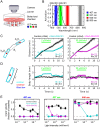Optogenetic Neuronal Silencing in Drosophila during Visual Processing
- PMID: 29061981
- PMCID: PMC5653863
- DOI: 10.1038/s41598-017-14076-7
Optogenetic Neuronal Silencing in Drosophila during Visual Processing
Abstract
Optogenetic channels and ion pumps have become indispensable tools in neuroscience to manipulate neuronal activity and thus to establish synaptic connectivity and behavioral causality. Inhibitory channels are particularly advantageous to explore signal processing in neural circuits since they permit the functional removal of selected neurons on a trial-by-trial basis. However, applying these tools to study the visual system poses a considerable challenge because the illumination required for their activation usually also stimulates photoreceptors substantially, precluding the simultaneous probing of visual responses. Here, we explore the utility of the recently discovered anion channelrhodopsins GtACR1 and GtACR2 for application in the visual system of Drosophila. We first characterized their properties using a larval crawling assay. We further obtained whole-cell recordings from cells expressing GtACR1, which mediated strong and light-sensitive photocurrents. Finally, using physiological recordings and a behavioral readout, we demonstrate that GtACR1 enables the fast and reversible silencing of genetically targeted neurons within circuits engaged in visual processing.
Conflict of interest statement
The authors declare that they have no competing interests.
Figures




Similar articles
-
Behavioral Assays for Optogenetic Manipulation of Neural Circuits in Drosophila melanogaster.J Vis Exp. 2025 Feb 7;(216):10.3791/67964. doi: 10.3791/67964. J Vis Exp. 2025. PMID: 39995158
-
Optogenetics in Drosophila Neuroscience.Methods Mol Biol. 2016;1408:167-75. doi: 10.1007/978-1-4939-3512-3_11. Methods Mol Biol. 2016. PMID: 26965122
-
Optogenetic inhibition of behavior with anion channelrhodopsins.Nat Methods. 2017 Mar;14(3):271-274. doi: 10.1038/nmeth.4148. Epub 2017 Jan 23. Nat Methods. 2017. PMID: 28114289
-
Electrophysiological Recordings from Lobula Plate Tangential Cells in Drosophila.Methods Mol Biol. 2016;1478:321-332. doi: 10.1007/978-1-4939-6371-3_20. Methods Mol Biol. 2016. PMID: 27730592 Review.
-
Silencing Neurons: Tools, Applications, and Experimental Constraints.Neuron. 2017 Aug 2;95(3):504-529. doi: 10.1016/j.neuron.2017.06.050. Neuron. 2017. PMID: 28772120 Free PMC article. Review.
Cited by
-
Heterogeneous side effects of cortical inactivation in behaving animals.Elife. 2021 Sep 10;10:e66400. doi: 10.7554/eLife.66400. Elife. 2021. PMID: 34505577 Free PMC article.
-
Neural circuit mechanisms for steering control in walking Drosophila.Elife. 2025 Jul 21;13:RP102230. doi: 10.7554/eLife.102230. Elife. 2025. PMID: 40690376 Free PMC article.
-
Astrocytes close a motor circuit critical period.Nature. 2021 Apr;592(7854):414-420. doi: 10.1038/s41586-021-03441-2. Epub 2021 Apr 7. Nature. 2021. PMID: 33828296 Free PMC article.
-
Kalium channelrhodopsins effectively inhibit neurons.Nat Commun. 2024 Apr 24;15(1):3480. doi: 10.1038/s41467-024-47203-w. Nat Commun. 2024. PMID: 38658537 Free PMC article.
-
Behavioral Assays for Optogenetic Manipulation of Neural Circuits in Drosophila melanogaster.J Vis Exp. 2025 Feb 7;(216):10.3791/67964. doi: 10.3791/67964. J Vis Exp. 2025. PMID: 39995158
References
Publication types
MeSH terms
LinkOut - more resources
Full Text Sources
Other Literature Sources
Molecular Biology Databases
Research Materials

